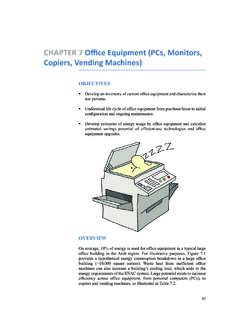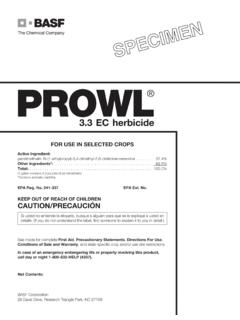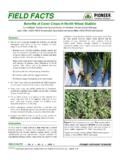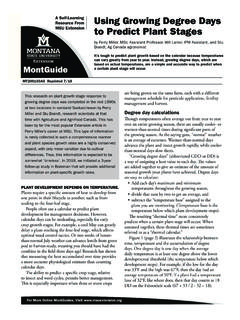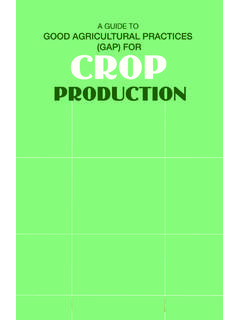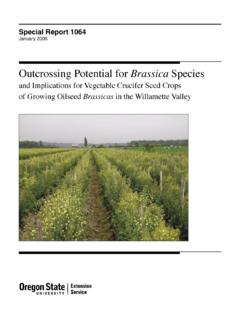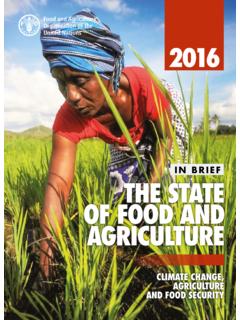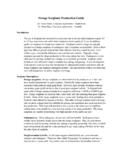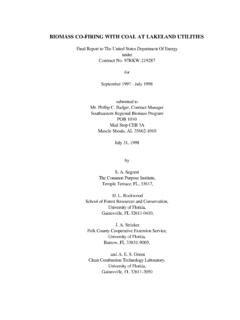Transcription of CHAPTER 5 Water efficiency in agriculture - AFED
1 72 CHAPTER 5 water efficiency in agriculture Globally, agriculture is the largest user of water1 and also uses 85% of the Water withdrawn in the MENA region. Additionally, Water use in agriculture is often highly inefficient with only a fraction of the Water diverted for agriculture effectively used for plant growth, with the rest drained or lost via evapotranspiration. With population growth and rising affluence, the need for food and thus agricultural Water for irrigation is increasing. At the same time the quantity of Water with a sufficient quality is declining. There is also an increasing demand to shift more of the Water used in agriculture to higher-value urban and industrial uses.
2 Thus, producing more with less is the only option. Water efficiency in agriculture has been extensively researched for many years. Universally applicable solutions are however difficult to come by, particularly due to different contexts and high specificity of agricultural practices. But efficiency gains are often possible through suitable crop selection, proper irrigation scheduling, effective irrigation techniques, and using alternative sources of Water for irrigation. It should be noted that increasing Water efficiency often provides benefits that go far beyond reduced Water use. 1 Vital Water Graphics.
3 An Overview of the State of the World s Fresh and Marine Waters - 2nd Edition - 2008 Water efficiency of irrigation can be improved by making the right decisions regarding: Crop selection Irrigation scheduling Irrigation methods Source of Water . 73 IMPROVING Water efficiency IN IRRIGATION Irrigation is necessary when plants cannot satisfy all their Water needs through natural precipitation this practice is also called deficit irrigation. Therefore, an ideal irrigation effort aims to cover the deficit between a crop s optimal Water needs and what it can take up through natural means. Because arid, semi-arid, and desert climatic conditions prevail in the Arab region, irrigation is indispensible.
4 Climatic conditions, soil type and structure, plant type, and the irrigation techniques applied are among the main factors that influence the efficiency and effectiveness of irrigation practices. For a given location and climatic and soil conditions, the efficiency of Water irrigation practices can be improved by making the right decisions regarding: Crop type Irrigation scheduling Irrigation method Soil enhancement measures Source of Water CROP Water NEEDS Crops differ both in terms of their daily Water needs and the duration of their total growing period. Consequently, crop type is a chief factor influencing irrigation Water needs.
5 Crops with high daily needs and a long total growing season require much more Water than those with relatively lower daily needs and shorter growing seasons. Therefore, a key step towards reducing irrigation Water needs is selecting those crop varieties that have a lower Water demand but that still provide sufficient added value. Improving Irrigation practices can: Reduce Water and pumping costs Reduce costs for fertilizers and other agricultural chemicals Maintain a higher soil quality Increase crop yields by as much as 100%. 74 In Tables , , and , values of typical Water needs, average length of growing season, and the total Water demand for different crops are given.
6 Water requirement as compared to ordinary grass30% less10% less Same10% more30% more Citrus Cucumber Carrots Barley Paddy rice Olives Radishes Crucifers (Cabbage, Cauliflower, Broccoli, etc.) Beans Sugarcane Grapes Squash Maize Banana Flax Tobacco Small grains Nuts and fruit trees with cover crops Lettuce Cotton Mellons Tomato Onions Eggplant Peanuts Lentils Peppers Millet Spinach Oats Tea Peas Grass Cacao Coffee Potatoes Safflower Sorghum Clean cultivated nuts & fruit trees Soybeans Sugarbeet Sunflower Table : Water needs of field crops in peak period as compared to standard grass2 Crop Total growing period (days) CropTotal growing period (days) Alfalfa 100 365 Millet 105 140 Banana 300 365 Onion green 70 95 Barley/Oats/Wheat 120 150 Onion dry 150 210 Bean green 75 90 Peanut 130 140 Bean dry 95 110 Pea 90 100 Cabbage 120 140 Pepper 120 210 Carrot 100 150 Potato 105 145 Citrus 240 365 Radish 35 45 Cotton 180 195 Rice 90 150 Cucumber 105 130 Sorghum 120 130 Eggplant 130 140 Soybean 135 150 Flax 150 220 Spinach 60 100 Grain/small 150 165 Squash 95 120 Lentil 150 170 Sugarbeet 160 230 Lettuce 75 140 Sugarcane 270 365 Maize sweet 80 110 Sunflower 125 130 Maize grain 125 180 Tobacco 130 160 Mellon 120 160 Tomato 135 180 Table.
7 Indicative values of the total growing period for different crops3 2 FAO, 1986. Irrigation Water Management: Irrigation Water needs. 3 Ibid. 75 Crop Crop Water need (mm/total growing period) Alfalfa 800 1600 Banana 1200 2200 Barley/Oats/Wheat 450 650 Bean 300 500 Cabbage 350 500 Citrus 900 1200 Cotton 700 1300 Maize 500 800 Mellon 400 600 Onion 350 550 Peanut 500 700 Pea 350 500 Pepper 600 900 Potato 500 700 Rice (paddy) 450 700 Sorghum/Millet 450 650 Soybean 450 700 Sugarbeet 550 750 Sugarcane 1500 2500 Sunflower 600 1000 Tomato 400 800 Table : Approximate values of seasonal crop Water needs4 IRRIGATION SCHEDULING Irrigation scheduling helps eliminate or reduce instances where too little or too much Water is applied to crops.
8 Scheduling is performed by all growers in one way or another. However, proper irrigation scheduling involves fine-tuning the time and amount of Water applied to crops based on the Water content in the crop root zone, the amount of Water consumed by the crop since it was last irrigated, and crop development stage. Direct measurement of soil moisture content is among the most useful methods for irrigation scheduling. The extent to which farmers can utilize advanced irrigation depends on their access to Water and labor. The economics, and in particular the critical impact of Water availability on the yield, also play a role on the uptake of advanced irrigation scheduling.
9 Crops need different amounts of Water at different stages of their growth cycle. In addition, local climatic and soil conditions influence the availability of Water to crops. It should be kept in mind that excessive Water provision can also be counterproductive as crops cannot utilize excess Water and may be stressed from reduced oxygen levels of saturated soil. 4 Ibid. 76 This practice will also waste not only Water but also energy and pumping costs. Consequently, it is essential to plan for irrigation properly and match the amount of Water provided to a crop s Water needs both for yield optimization and for Water efficiency .
10 With proper irrigation scheduling, soil reservoir is managed such that optimum amount of Water is available when the plants need it. Good irrigation scheduling requires knowledge of: Crop Water demand at different growth cycles Moisture content of the soil and soil Water capacity Weather conditions. During the early season planting stage, the Water requirement is usually about 50% less than what is required at the mid-season stage, when the crop has fully developed and reached its peak Water need. The late season demand, on the other hand, is as high as the peak demand for crops harvested fresh, and can be as much as 75% less for those plants harvested dry.


